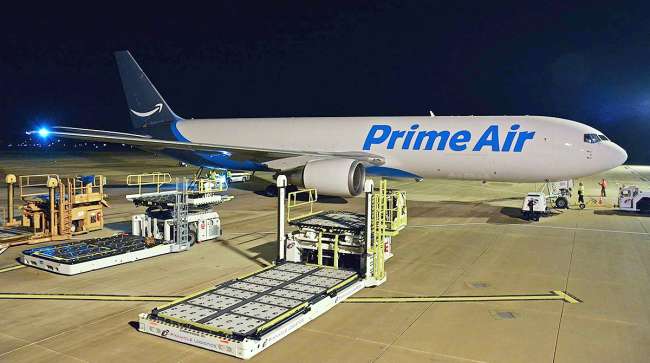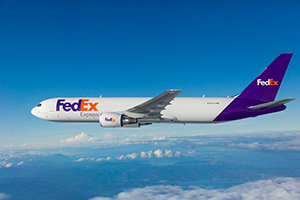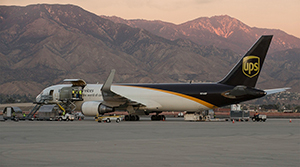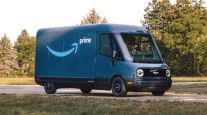Senior Reporter
As Amazon Air Expands, Report Sees Potential Challenge to UPS, FedEx and USPS

[Stay on top of transportation news: Get TTNews in your inbox.]
Amazon Air is poised for a summertime growth spurt that could send its daily schedule to more than 160 flights per day and expand its fleet to make it a potential carrier of business-to-consumer packages outside the Amazon.com network, positioning the company as a competitor to FedEx Corp., UPS Inc., the U.S. Postal Service and other air and ground carriers, a new report said.
“Amazon is a star performer in the air cargo world,” said Joseph Schwieterman, director of DePaul University of Chicago’s Chaddick Institute for Metropolitan Development and a co-author of “Primed and Positioned, Strategic Moves by Amazon Air,” a report from the institute, which analyzed Amazon Air’s growth and expanding flight schedule in the U.S. and Europe.
“It’s taking some risks to help build up the network rapidly, no doubt to help protect the company’s supply chain,” Schwieterman told Transport Topics.
Amazon Air Primed and Posit... by Transport Topics
The report said Amazon Air grew its flight schedule by 15% between August 2020 and February, adding 18 flights. More expansion is planned — both in Europe and domestically — with a focus on its largest hubs. Those include Cincinnati-Northern Kentucky International Airport, Ontario International Airport east of Los Angeles, Rockford International Airport northwest of Chicago, and Fort Worth’s Alliance Airport.

FedEx operates nearly 680 planes. (FedEx Corp.)
The report said more flights at those airports along with expansion at 27 other domestic airports would allow Amazon to cover all of the United States. The Cincinnati-Northern Kentucky airport is especially critical since cargo can be hauled from there by truck in fewer than 10 hours to portions of the East Coast, Mid-Atlantic, South and Midwest.
“As Amazon moves to more next-day delivery, it needs to improve its connections with its warehouses and fulfillment centers,” Schwieterman said. “Amazon Air appears to be built around the principle that inventory needs to move rapidly to be positioned for overnight delivery.”
Amazon in 2019 announced a $1.9 billion expansion at Cincinnati-Northern Kentucky Airport, allowing 50 aircraft to operate there and employing 2,000 people. The project is set for completion this year. In 2018 it announced an expansion of ground operations in Wilmington, Ohio, and signed a five-year agreement to operate from that airport.
The report suggested Amazon could use the 2021 holiday season as a testing period for expanded coverage, then consider expanding more broadly into business-to-consumer deliveries.
“Amazon’s entry into this business will likely occur in the next 18 months, and when it occurs, Amazon Air — and the [Cincinnati]/Wilmington hubs in particular — will be critical,” Schwieterman said.
If Amazon reaches 160 flights by June, it will have more than doubled in 13 months.
A November 2020 report from investment banker Morgan Stanley forecast Amazon could utilize its end-to-end logistics system to begin delivery services to outside businesses by the end of this year. Schwieterman agrees, but believes Amazon’s business model would be somewhat different from the industry’s global delivery leaders.
“The moves that Amazon is making position it to become an effective third-party logistics provider,” he said. “If they move into that space, it will likely be business-to-consumer, since their supply chain is mostly orientated to delivering packages rather than collecting them from millions of different points. The delivery business is dominated by UPS and FedEx, so there is ample room for a new player to grab a piece of the pie.”

UPS uses 572 planes. (San Bernardino International Airport)
Schwieterman noted that Amazon is already experimenting with a business-to-consumer delivery service in the United Kingdom called Amazon Shipping. Companies not on the Amazon.com platform use the program for delivery services. If the initiative proves successful, Schwieterman believes Amazon will expand it to the U.S. — possibly working with retailers who deal directly with consumers, such as home furnishing giant Wayfair.com. Amazon briefly tested a similar delivery program in the U.S. last April, but it was shelved because of the COVID-19 pandemic and the strains it placed on Amazon’s delivery network.
An Amazon official contacted by TT said the Seattle-based company had no comment on the DePaul report.
Currently, Amazon leases most of its aircraft from Atlas Air Worldwide Holdings and Air Transport Services Group. Last month it was disclosed Amazon had purchased 11 used Boeing 767-300 jets from Delta and Canadian air carrier WestJet, and would begin converting the planes from passenger to cargo use.
When the refurbished jets are put into service, they will bring to 85 the number of planes Amazon has in its fleet. But that’s substantially smaller than competitors UPS, which leases, owns or operates 572 planes, and FedEx, which operates nearly 680 planes.
Want more news? Listen to today's daily briefing below or go here for more info:




